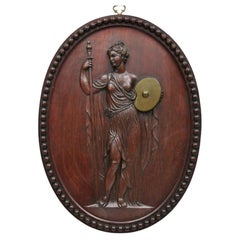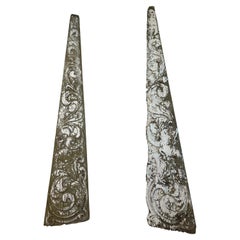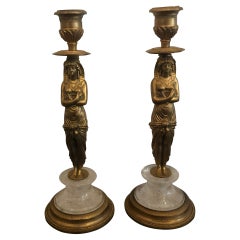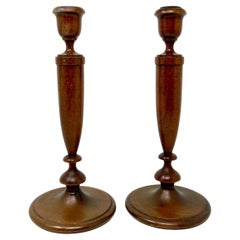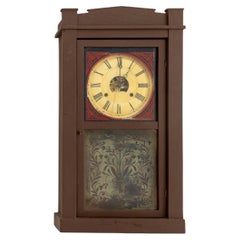American Classical Decorative Objects
to
71
202
8
4
36
166
12
42
35
40
3
4
8
5
5
2
7
8
6
8
26,019
14,039
9,142
5,467
3,963
3,006
2,276
1,732
1,408
1,338
1,151
1,140
1,023
935
919
662
659
579
97
46
33
32
24
191
18
157
152
26
10
8
Height
to
Width
to
214
213
213
4
3
3
2
2
Style: American Classical
Antique Classical Oval Carved Mahogany Figural Goddess Wall Sculpture Plaque
Located in Philadelphia, PA
Antique Classical Oval Relief Carved Mahogany Figural Goddess Wall Sculpture Plaque. Circa Early 1900s. Measurements: 16" H x 12" W x 1.75" D.
Category
Early 1900s Antique American Classical Decorative Objects
Materials
Mahogany
19th Century Maritime Bowsprits Architectural Fragments
Located in Essex, MA
These unusual Bowsprits are John Haley Bellamy quality, intricately carved, tapered boards with traces of colored paint in the recessed portions. La...
Category
19th Century American Antique American Classical Decorative Objects
Materials
Wood
American "Man Riding Donkey" Patinated Bronze
Located in Astoria, NY
American "Man Riding Donkey" Patinated Bronze Sculpture, early 20th century, depicting a man holding a vessel riding a donkey on a rectangular base, signed "Roman Bronze Works N.Y."....
Category
Early 20th Century American American Classical Decorative Objects
Materials
Bronze
Pair Rock Crystal Candlesticks
Located in Dallas, TX
Pair of bronze dore and rock crystal candlesticks.
Category
1990s North American American Classical Decorative Objects
Materials
Bronze
$880 Sale Price / set
20% Off
Pair Vintage Hand Carved Turned Wood Candlesticks, Candle Holders
Located in Chicago, IL
Hand carved solid wood candlesticks in the classic hand turned style with lovely proportions. Exact age and maker unknown.
Very good vintage condition. Very minor signs of wear. No ...
Category
Early 20th Century American American Classical Decorative Objects
Materials
Hardwood
Chauncey Jerome Verre Eglomise Clock, 1857
Located in Astoria, NY
Chauncey Jerome Verre Eglomise Shelf Clock, New Haven, Connecticut, circa 1857, label to interior. 27" H x 14.75" W x 4.5" D. Provenance: From a 333 East 75th Street Estate.
Category
1850s Antique American Classical Decorative Objects
Materials
Glass, Wood
$450 Sale Price
47% Off
Art by Araun Gordijn Fuel Pomp and VW Door
Located in Delft, NL
Art by Araun Gordijn Fuel Pomp and VW Door
Art, Fuel pomp connected to a VW door
Two pieces
Made of wood, plastic and glass
Made by Araun Gordijn born in 1947 Amsterdam
Hand made ob...
Category
Late 20th Century Dutch American Classical Decorative Objects
Materials
Wood
Tan Leather Tray
Located in Westwood, NJ
With soft creamy mushroom tan leather, this leather tray is fraught with detail: the topstitching of each leather panel, the narrow leather straps that hold the stainless steel handl...
Category
21st Century and Contemporary Asian American Classical Decorative Objects
Materials
Metal
$334 Sale Price / item
29% Off
Sister Miller Round Basket with Cover
Located in Boca Raton, FL
Unique handmade and signed by Sister Miller round basket with cover and leather handles.
Category
21st Century and Contemporary American American Classical Decorative Objects
Materials
Bentwood
$175 Sale Price
30% Off
Antique Brandt Furniture Co. Inlaid Mahogany 4 Bottle Decanter Spirit Box
Located in Chicago, IL
Antique Brandt Furniture Co. Inlaid Mahogany 4 Bottle Decanter Spirit Box
This Brandt Furniture Co. decanter box has a beautiful four bottle ...
Category
1930s American Vintage American Classical Decorative Objects
Materials
Velvet, Mahogany
Antique Reed & Barton American Edwardian Classical Sterling Silver Trophy Cup
Located in New York, NY
Turn-of-the-century Edwardian sterling silver trophy cup. Made by Reed & Barton in Taunton, Mass. Faceted baluster with scalloped and beaded rim. Reeded and leaf-capped, -wrapped, an...
Category
Early 20th Century American American Classical Decorative Objects
Materials
Sterling Silver
Antique C.F. Blanke Tea and Coffee Company Exposition Brand Green Tin Coffee Bin
Located in Chicago, IL
Antique C.F. Blanke Tea and Coffee Company Exposition Brand Green Tin Coffee Bin
This antique forest green coffee bin with a slanted lid opening has an exterior reading: "Blankes Ex...
Category
Early 20th Century American American Classical Decorative Objects
Materials
Metal
American Antique Woven Straw Box
Located in Boca Raton, FL
Rare American antique handwoven tri color straw box in great condition. Great decorative piece and collectible.
Category
1920s American Vintage American Classical Decorative Objects
Materials
Straw
Vintage Tom Bennett Hand-Signed "Autumn" Bronze Nude Female Dancer Sculpture
By Tom Bennett
Located in Chicago, IL
Vintage Limited Edition Tom Bennett Hand-Signed Numbered "Autumn" Bronze Nude Female Dancer Sculpture 137/250
The limited edition Tom Bennett "Autumn" bronze nude female dancer scul...
Category
Late 20th Century American American Classical Decorative Objects
Materials
Bronze
American Oil on Board Landscape with Young Lady and Rabbit, Circa 1820
Located in Charleston, SC
American oil on board landscape of young lady standing by rabbit in foreground with the original molded pine frame and wood backing. Early 19th century.
Category
1820s American Antique American Classical Decorative Objects
Materials
Pine, Paint
Antique Clasped Hands Awards Mold
Located in Stamford, CT
antique brass or bronze mold for making a set of clasped or shaking hands. Most likely fraternal. Fine detail work. No cracks or breaks. Untouched surface.
Free shipping in the conti...
Category
1920s American Vintage American Classical Decorative Objects
Materials
Brass
Clear Glass Crystal Candlesticks
Located in Ferndale, MI
Pair of low crystal glass candlesticks.
Category
Mid-20th Century American American Classical Decorative Objects
Materials
Glass
$275 Sale Price
21% Off
Antique Gorham American Victorian Classical Coin Silver Vase
Located in New York, NY
Victorian Classical coin silver vase. Made by Gorham in Providence, ca 1860. Conical bowl with everted curvilinear rim; tapering bracket side handles mounted with cast female heads a...
Category
Mid-19th Century American Antique American Classical Decorative Objects
Materials
Silver
Boston Classical Coin Silver Basket by Haddock, Lincoln & Foss
Located in New York, NY
Classical coin silver basket. Made by Haddock, Lincoln & Foss in Boston, ca 1860. Round and curved with four cast leaf-mounted leaf supports. Beaded...
Category
Mid-19th Century American Antique American Classical Decorative Objects
Materials
Silver
Bronze Elephant Sculpture by David Shaefer
Located in Dallas, TX
This listing features a patinated bronze sculpture of an African elephant by the artist David Schaefer. Signed 'D. Shaefer' to base, copy 306/450.
Thi...
Category
20th Century Kenyan American Classical Decorative Objects
Materials
Bronze
Vintage Boho Monumental Glazed Ceramic Bowl
Located in West Palm Beach, FL
Elevate your decor with this Vintage Boho Monumental Glazed Ceramic Bowl, a striking piece that embodies the mystique of ancient artistry. Adorned with a hand-painted dragon motif in...
Category
21st Century and Contemporary American American Classical Decorative Objects
Materials
Ceramic
Folk Art Hand Carved Coyote Floor Standing Sculpture
Located in Saddle River, NJ
Decorative Hand Carved Coyote Floor Standing Sculpture.
Add a touch of rustic charm to your home with this stunning Decorative Hand Carved Coyote Floor Standing Sculpture. This uniq...
Category
1990s American American Classical Decorative Objects
Materials
Wood
Pair Mid-century Pressed Glass Candle Holders
Located in West Palm Beach, FL
Solid glass candle holders from the pressed glass era (1930-1950). Solid, and pure in their simplicity.
Category
Mid-20th Century American American Classical Decorative Objects
Materials
Glass
Scalloped Round Decorative Souvenir Plate in Emerald from Kingfisher Oklahoma
Located in Oklahoma City, OK
Round circular scalloped souvenir plate or dish from Kingfisher Oklahoma. This beautiful plate features a lovely emerald green ombre around the edges an...
Category
Mid-20th Century Austrian American Classical Decorative Objects
Materials
Ceramic, Paint
$120 Sale Price
20% Off
Vintage Cast Stone Bust of Male Figure
Located in Los Angeles, CA
Solid Cast Stone bust of male figure. Signed on the side.
Flat base can sit on mantle, pedestal or table.
See images for condition.
Category
Late 20th Century American American Classical Decorative Objects
Materials
Cast Stone, Concrete
$2,624 Sale Price
20% Off
Giant Bishop Chess Piece Wooden Sculpture With Secret compartiment
Located in Buenos Aires, Olivos
Very nice giant Bishop chess piece. Made of several woods following a pattern. The top comes off, and it has something like an urn, maybe a secret hidden place.
Chess is a two-playe...
Category
1910s Unknown Vintage American Classical Decorative Objects
Materials
Wood
$1,760 Sale Price
20% Off
Silver Stallion Wood, Tooled Leather, Polished Steel Desk Clock
Located in Santa Barbara, CA
The Silver Stallion is one of several high end Western themed items produced by Steven Handelman Studios in 2019. The consept was to make something th...
Category
20th Century American American Classical Decorative Objects
Materials
Iron
Antique Paul Revere Pottery Saturday Evening Girls Bowl Signed and Dated 1/20
Located in Westfield, MA
This stunning bowl from Paul Revere Pottery, crafted by the Saturday Evening Girls (SEG) pottery collective, showcases the artisanal beauty and c...
Category
1920s American Vintage American Classical Decorative Objects
Materials
Pottery
Glassy Cluster Of Pointed Terminated Faden Quartz Crystal From Pakistan
By Deloris "Dee" Giltz 1
Located in Peshawar, PK
Product Information:
Specimen Type: Faden Quartz Crystal
Weight: 37 grams
Dimension: H: 8.8 x W: 3 x D: 2 cm
Origin: Baluchistan Province, Pakistan
Treatment: None
Description:...
Category
21st Century and Contemporary Pakistani American Classical Decorative Objects
Materials
Crystal, Quartz, Rock Crystal, Other
A most impressive bronze bust of a 1920s South American gentleman.
Located in Central England, GB
This most unusual almost life sized heavily cast bronze bust depicts a very smart most likely South American gentleman dressed in a double breasted suit jacket with a shirt and tie. ...
Category
Early 20th Century French American Classical Decorative Objects
Materials
Bronze
Large American White Marble Bust of a Gentleman by Randolph Rogers
By Randolph Rogers
Located in Tarzana, CA
Fine 19th century white carved marble bust of a gentleman with mustache wearing a Toga.
Signed: Randolph Rogers, Rome.
Randolph John Rogers (July 6, 1825, Waterloo, New York – January 15, 1892, Rome, Italy) was an American Neoclassical sculptor. An expatriate who lived most of his life in Italy, his works ranged from popular subjects to major commissions, including the Columbus Doors at the U.S. Capitol and American Civil War monuments. Born in Waterloo, New York, he spent most of his childhood in Ann Arbor, Michigan. He developed an interest in wood cuts and wood engraving, and moved to New York City about 1847, but was unsuccessful in finding employment as an engraver. While working as a clerk in a dry-goods store, his employers discovered his native talent as a sculptor and provided funds for him to travel to Italy. He began study in Florence in 1848, where he studied briefly under Lorenzo Bartolini. He then opened a studio in Rome in 1851. He resided in that city until his death in 1892.
He began his career carving statues of children and portrait busts of tourists. He was not happy working with marble consequently all his marble statues were copied in his studio by Italian artisans under his supervision, from an original produced by him in another material. This also enabled him to profit from his popular works. His first large-scale work was Ruth Gleaning...
Category
19th Century Italian Antique American Classical Decorative Objects
Materials
Marble
Collection of Table Ornaments 19th and 20th Century, Cut Crystal, Gilt Bronze
Located in Buchanan, MI
A collection of table ornaments, cut crystal gilt bronze
19th and 20th century, priced per item.
Height of tallest 20 1/4 inches.
Category
19th Century English Antique American Classical Decorative Objects
Materials
Crystal, Bronze
Drip-proof Glass Saucers for Candlesticks or Chandeliers: 9 Items
Located in Alessandria, Piemonte
Drip-proof glass saucers for candlesticks or chandelier. In ancient times they were used to collect dripping was, now it is above all an ornament that completes a chandelier.
ref. ...
Category
Late 20th Century French American Classical Decorative Objects
Materials
Art Glass
American Classical decorative objects for sale on 1stDibs.
Find a broad range of unique American Classical decorative objects for sale on 1stDibs. Many of these items were first offered in the 21st Century and Contemporary, but contemporary artisans have continued to produce works inspired by this style. If you’re looking to add vintage decorative objects created in this style to your space, the works available on 1stDibs include decorative objects, serveware, ceramics, silver and glass, folk art and other home furnishings, frequently crafted with metal, wood and other materials. If you’re shopping for used American Classical decorative objects made in a specific country, there are North America, United States, and Europe pieces for sale on 1stDibs. While there are many designers and brands associated with original decorative objects, popular names associated with this style include Longaberger, Chesterfield, Hubley Manufacturing Company, and Massimo Marcomini. It’s true that these talented designers have at times inspired knockoffs, but our experienced specialists have partnered with only top vetted sellers to offer authentic pieces that come with a buyer protection guarantee. Prices for decorative objects differ depending upon multiple factors, including designer, materials, construction methods, condition and provenance. On 1stDibs, the price for these items starts at $30 and tops out at $55,000 while the average work can sell for $850.
Recently Viewed
View AllMore Ways To Browse
Terracotta Anthropomorphic
Toikka Bird
Toucan Glass Sculpture
Turkish Olive Jar
Turquoise Bottle Vase
Turquoise Foo Dogs
Very Large Antique Clock
Vintage Blown Glass Bird
Vintage Ceramic Mermaid
Vintage Cologne Bottles
Vintage Copper Decor
Vintage Desimone Pottery
Vintage Lion Figurine
Vintage Murano Glass Cat
Vintage Pot Plant Holders
West Germany Yellow
White Horse Porcelain
Wood Ram Sculpture
